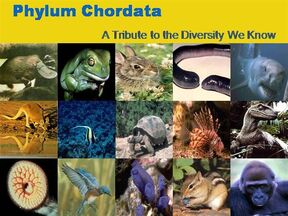
The Phylum Chordata includes the well-known vertebrates (fishes, amphibians, reptiles, birds, mammals). The vertebrates and hagfishes together comprise the taxon Craniata. The remaining chordates are the tunicates (Urochordata), lancelets (Cephalochordata), and, possibly, some odd extinct groups. With few exceptions, chordates are active animals with bilaterally symmetric bodies that are longitudinally differentiated into head, trunk and tail. The most distinctive morphological features of chordates are the notochord, nerve cord, and visceral clefts and arches.
Chordates are well represented in marine, freshwater and terrestrial habitats from the Equator to the high northern and southern latitudes. The oldest fossil chordates are of Cambrian age. The earliest is Yunnanozoon lividum from the Early Cambrian, 525 Ma (= million years ago), of China. This was just recently described and placed with the cephalochordates. Another possible cephalochordate is Pikaia from the Middle Cambrian. These fossils are highly significant because they imply the contemporary existence of the tunicates and craniates in the Early Cambrian during the so-called Cambrian Explosion of animal life. Two other extinct Cambrian taxa, the calcichordates and conodonts, are uncertainly related to other Chordata. In the Tree of Life project, conodonts are placed as a subgroup of vertebrates.
Chordates other than craniates include entirely aquatic forms. The strictly marine Urochordata or Tunicata are commonly known as tunicates, sea squirts, and salps. There are roughly 1,600 species of urochordates; most are small solitary animals but some are colonial, organisms. Nearly all are sessile as adults but they have free-swimming, active larval forms. Urochordates are unknown as fossils. Cephalochordata are also known as amphioxus and lancelets. The group contains only about 20 species of sand-burrowing marine creatures.
The Cambrian fossils Yunnanozoon and Pikaia are likely related to modern cephalochordates.
During the Ordovician Period (510 -439 Ma) jawless or agnathan fishes appeared and diversified. These are the earliest known members of Vertebrata, the chordate subgroup that is most familiar to us. Fossils representing most major lineages of fish-like vertebrates and the earliest tetrapods (Amphibia) were in existence before the end of the Devonian Period (363 Ma). Reptile-like tetrapods originated during the Carboniferous (363 - 290 Ma), mammals differentiated before the end of the Triassic (208 Ma) and birds before the end of the Jurassic (146 Ma).
The smallest chordates (e.g. some of the tunicates and gobioid fishes) are mature at a length of about 1 cm, whereas the largest animals that have ever existed are chordates: some sauropod dinosaurs reached more than 20 m and living blue whales grow to about 30 m.